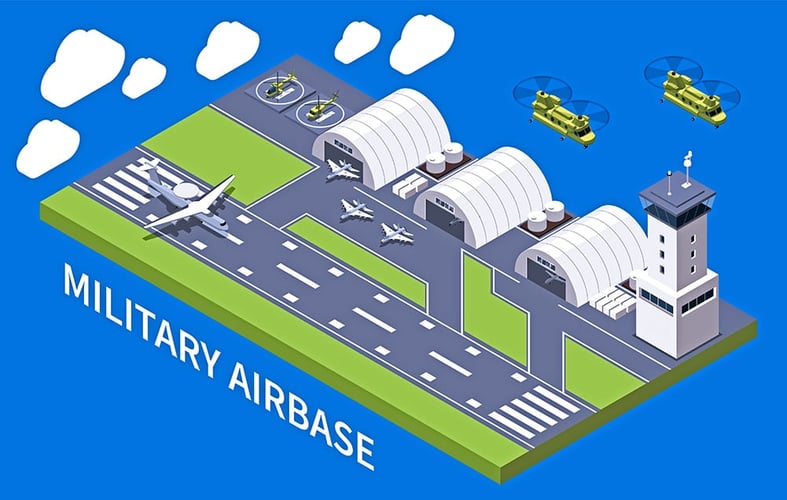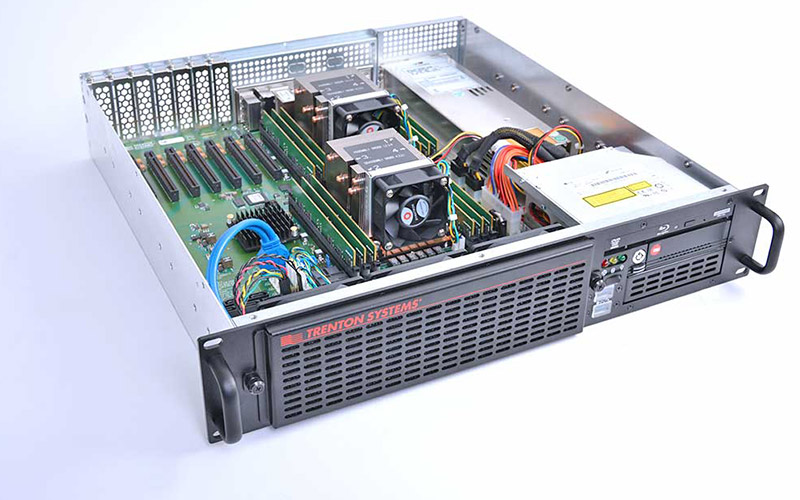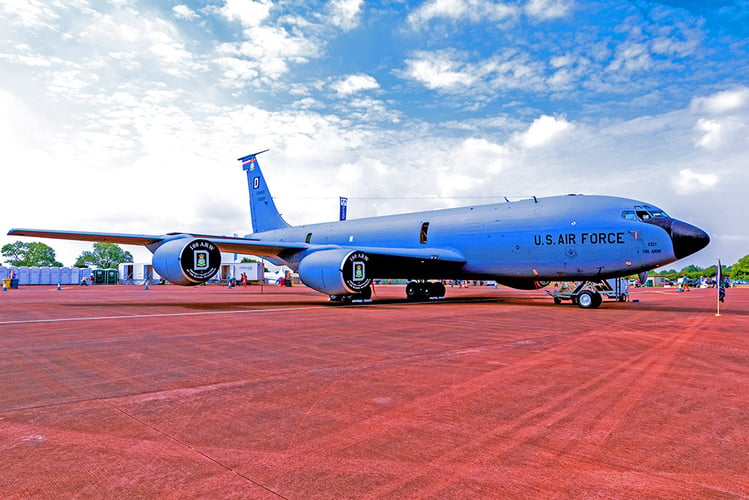Share this
Integrated Base Defense: How the U.S. Air Force Protects Its Assets
by Brett Daniel on Sep 24, 2020 10:42:52 AM
Photo: Integrated Base Defense (IBD) as we know it today has been a topic of conversation for the Air Force for more than a decade now. But what is IBD, and why has the Air Force declared 2020 the "Year of Integrated Base Defense?" Learn all about IBD in this blog post.
Table of Contents
- What is integrated base defense?
- Where does the concept of integrated base defense come from?
- How are integrated base defense objectives achieved?
- Is integrated base defense effective?
- Why is integrated base defense important in 2020?
- Trenton Systems: A Trusted Choice for Integrated Base Defense
Introduction
When aircraft are removed from their natural environment of the air and returned to their bases, they become vulnerable, like any bird of prey in its nest.
- Joseph Milner, Colonel, United States Air Force
Milner’s quote, taken from his Air Force Research Institute Paper on the need for Integrated Base Defense (IBD), opens a dialogue about a defense dilemma that should be discussed more often: how the U.S. Air Force protects the assets that allow Air Force personnel to do their jobs, protect themselves and others, ensure air force base security, and in turn, achieve effective national security.
The U.S. Air Force has officially declared 2020 the "Year of Integrated Base Defense," and in late July, held AFWERX Fusion 2020, where leaders discussed the Air Force's Base of the Future initiative.
The initiative is made of up six challenges, one of which is entitled "Base Security and Defense." Its mission is to "protect the people and critical resources" of U.S. Air Force bases by enhancing security and strengthening perimeter defenses. This is, in a nutshell, what IBD is all about.
In this blog post, we’ll talk about integrated base defense, what it is, its history, its objectives, and its future, particularly in the context of the emerging use of technologies like artificial intelligence (AI), machine learning (ML), unmanned aerial systems (UAS), and edge computing in military applications.
We'll also discuss what the Air Force Security Forces had to say about IBD at AFWERX, as well as why you should choose made-in-USA quality and reliability for your IBD and other mission-critical applications every single time.

Graphic: In practice, IBD is a concerted effort between military and non-military forces to better protect U.S. Air Force bases around the world. It also encompasses the technologies used to accomplish this goal.
What is integrated base defense?
Integrated base defense, or IBD, is an umbrella term encompassing a host of activities that the United States Air Force carries out to protect its installations – the air force bases themselves - the bases’ assets – the aircraft, the base defense operations centers (BDOCs), and other interior and exterior base facilities - and most importantly, the members of the Air Force stationed at these bases.
The primary goal of IBD is to facilitate seamless cohesion, communication, and interoperability between existing base defense systems and cohorts to augment and improve overall base defense efforts.
According to the Physical Security Enterprise & Analysis Group (PSEAG), an arm of the Office of the Secretary of Defense responsible for DoD security equipment research, development, testing, and evaluation, these improvements include:
- Automated display of threat data
- Fusion and correlation of base defense information
- Assessment and dissemination of threat information via a shared Graphical User Interface (GUI)
- Reduction of troop-to-task ratio and training requirements
According to a summary of a $495 million IBD contract won by Science Applications International Corporation (SAIC), L3Harris Technologies, and Northrop Grumman in 2009, there are 10 threat-related elements of IBD:
- Deceive
- Deter
- Anticipate
- Deny
- Detect
- Delay
- Assess
- Deploy
- Neutralize
- Mitigate
Graphic: The establishment of IBD stems from previous insufficiencies in air base protection efforts.
Where does the concept of integrated base defense come from?
Historically, the Air Force has considered threats originating outside of air base perimeters to be the responsibility of the other branches of the military or the nations in which U.S. Air Force bases are located, according to an Air Force Research Institute Paper authored by Col. Joseph Milner of the U.S. Air Force.
In this paper, Milner contends that events that occurred during the Vietnam War, the Gulf War, and the conflict in Iraq prove that these forces, as disparate, standalone sources of defense operations, are either generally lacking with regard to the effective execution of base defense operations, or they downplay certain risks that many air base commanders consider critically important to overall base security.
In response to these insufficiencies, the Air Force began developing IBD strategies and tactics, with instructive documents being released in the mid-2000s.
How are integrated base defense objectives achieved?
According to Milner, IBD emphasizes ground intelligence collection efforts, applies an interoperative defense systems approach, and creates a concerted base defense counterinsurgency plan between joint bases, the other branches of the military, host nations, and local civil authorities.
You can think of IBD as an “all hands on deck” approach to air base defense, with numerous military, government, and non-government forces involved in defending a base. In addition, the American military forces use intelligence, surveillance, and reconnaissance (ISR) data collected and processed by high-performance computing platforms to achieve their IBD objectives.
Is integrated base defense effective?
Milner’s research paper documents the first-ever IBD test at length. A summary of the paper is provided below, but you can read the entire study here.
The first operational IBD test occurred in 2008 at Joint Base Balad in Iraq, which experienced more than 400 attacks from insurgents in 2006 alone.
Previously, defense efforts at Balad had been mainly reactive: responses to insurgents were determined on the spot as an attack was happening.
But with IBD in place, proactivity was key: intelligence analysts and aircraft would gather data on Balad’s exterior terrain and use it to enhance security patrols. This, in turn, gave the local U.S. Army forces more time to develop and execute counterinsurgency (COIN) operations, with local government and non-government forces eventually being integrated into this force-symbiotic COIN plan.
As a result of this newly implemented, IBD-focused plan, the number of attacks on Balad decreased by 75 percent, and miss distances doubled. Overall, enemy loss of effectiveness increased by more than 90 percent.

Graphic: A rise in complex technologies that could potentially threaten U.S. Air Force bases is partly why IBD continues to be an essential initiative for the Air Force today.
Why is integrated base defense important in 2020?
As mentioned, the Air Force has declared 2020 the official year of IBD, and given the rise of sophisticated artificial intelligence (AI), machine learning (ML), unmanned aerial systems (UAS), and edge computing technologies in military operations around the world, integrated base defense security systems (IBDSS), with an emphasis on advanced cybersecurity protocols, is important now more than ever.
Threats to American air force bases may be better managed with IBD, but they’re becoming more complex, covert, and unpredictable due to advancements in technology. As such, the Air Force and its partners must continue to facilitate and innovate IBD through cohesive and effective collaboration between both personnel and the digital defense systems supporting related operations.
At the 2020 virtual event for AFWERX Fusion, the Air Force’s premier innovation program, Heidi Scheppers, deputy director, Security Forces, HQ AF/A4S, discussed the initial Integrated Base Defense Security Systems (IBDSS) program development document authored by the Air Force in 2005.
She stressed how the program has struggled to keep up over the years.
“When we drafted this document, we realized that we need systems designed to make decisions better and faster in order to respond to the many threats appropriately,” Scheppers said. “However, the IBDSS program has not kept pace with evolving threats, operations, technologies, policy guidance, or defense/security/law enforcement industry standards and best practices. Sustainment efforts to upgrade or refresh systems continue falling further and further behind, with some fielded systems in service for over 20 years.”
Referring specifically to the future of air base defense, Schepper said:
“We are integrating advanced technologies to ‘sense’ the base air picture and enable seamless physical to digital layered defense. The result is a digital layered defense system across all domains, using AI, ML, edge computing, UAS, and kinetic effects.”
And at the heart of the Air Force’s push for innovative IBDSS, Scheppers said, is a cyber-secure, multi-domain command, control and communications architecture powered by affordable, non-proprietary, COTS computer systems with open design principles - ergo, and open systems architecture.
According to Schepper, this architecture encompasses four aspects of defense:
- Defender Multi-Domain Command, Control and Communications (DMDC3) – to provide a platform that integrates computing power, means of communication, and situational awareness tools
- Platform for Integrated Command, Control, and Communications and Responsive Defense (PICARD) – to ensure ongoing development is performed with open design principles and open systems management, discarding outdated technology and implementing low-cost technology
- Defender Command, Control and Communications (DC3) – to integrate systems and networks in IBDSS and transport data in any form to get timely, relevant information to Air Force personnel in real or near-real time
- Defender Multi-Domain Situational Awareness Tool (DMSAT) – to ensure a mobile common operating picture interface and kit for all defenders
“These four aspects together will transform command and control centers with seamless integration. As a result, Security Forces will receive much more relevant and actionable information to better protect the manpower and assets. We must continue to innovate and adapt. This will ensure that the US military maintains our technical and tactical advantages that we have enjoyed since WW1.”

Photo: Trenton Systems' 2U rugged servers (above) are powering IBD systems this very second.
Trenton Systems: A Trusted Choice for Integrated Base Defense
Trenton Systems’ made-in-USA, mission-critical servers power integrated base defense security systems at U.S. Air Force bases around the world.
Situated in both racks and transit cases, these 2U rugged servers are used to surveil the bases’ interior and surrounding areas for potential threats and insurgents, delivering accurate, timely, relevant, and usable information to Air Force personnel in real or near-real time.
Due to the fast-paced nature of this mission-critical application, these systems must be in a constant state of operation, able to store and process surveillance data quickly, and fitted with high-powered graphics processing units (GPUs) and lots of PCI Express (PCIe) slots to run the bases’ surveillance programs efficiently and support any additional system expansion.
To support these outcomes, we recommended a 2U rugged server comprised of:
- 1 Ruggedized THS2005 Rack Mount Chassis
- 1 HDEC Series SEP8253 Processor Board
- 2 Intel Xeon Gold 6134 Processors
- One 650W Fixed, 95-265 VAC Power Supply
- 1 HDB8227 PCIe Backplane
- 1 PNY NVIDIA GeForce RTX 2080 Ti 11GB Blower Edition
- Eight 64 GB DDR4-2666 Memory Modules
- 2 Hot-Swappable 960GB SATA SSDs in a 3.5” Drive Bay
This is just one configuration, of course. Trenton Systems specializes in both custom and COTS solutions to serve the needs and requirements of its military, industrial, and commercial customers.
Choosing Trenton Systems for your military, commercial, and industrial applications also comes with a host of benefits, including but not limited to:
- Advanced cybersecurity and virtualization software from Star Lab, including their Titanium Security Suite and Crucible Embedded Hypervisor
- A 10-15-year computer life cycle
- Designed, manufactured, assembled, integrated, tested, and supported in the United States of America
- Revision control and end-of-life (EOL) notices
- Obsolescence control
- Custom BIOSes
- Stringent quality control
- A five-year warranty
- In-house shock, vibration, temperature, and humidity testing to MIL-STD-810, DO-160, and other leading compliance testing standards
- Limited lifetime support from in-house support engineers and staff
As discussed in this blog post and by our nation’s top Air Force leaders, the rise of AI, ML, UAS, and edge computing technologies in defense and warfare operations around the world poses a truly unique threat to air base defense, cybersecurity, and ultimately, national security.
Truly reliable and trusted rugged servers and workstations crafted within the nation’s borders and utilizing advanced cybersecurity software from leading cybersecurity companies are important now more than ever.
Given the continued proliferation of counterfeit parts, the infiltration of America's government and top industries through foreign microchips, email hacks, and other avenues, and the growing weaponization of AI and ML against American defense operations around the world, trusted rugged servers and workstations made in America with stringent quality control and top-notch cybersecurity measures should be the obvious choice for America's mission-critical defense systems.
Trenton Systems checks every box, from made-in-USA quality and reliability, the latest high-performance technologies, truly rugged durability, and advanced cybersecurity. Best of all, we’re here to cater to the needs of your program or application, and we'll do it right here at home, with you.
Share this
- High-performance computers (42)
- Military computers (38)
- Rugged computers (32)
- Cybersecurity (25)
- Industrial computers (25)
- Military servers (24)
- MIL-SPEC (20)
- Rugged servers (19)
- Press Release (17)
- Industrial servers (16)
- MIL-STD-810 (16)
- 5G Technology (14)
- Intel (13)
- Rack mount servers (12)
- processing (12)
- Computer hardware (11)
- Edge computing (11)
- Rugged workstations (11)
- Made in USA (10)
- Partnerships (9)
- Rugged computing (9)
- Sales, Marketing, and Business Development (9)
- Trenton Systems (9)
- networking (9)
- Peripheral Component Interconnect Express (PCIe) (7)
- Encryption (6)
- Federal Information Processing Standards (FIPS) (6)
- GPUs (6)
- IPU (6)
- Joint All-Domain Command and Control (JADC2) (6)
- Server motherboards (6)
- artificial intelligence (6)
- Computer stress tests (5)
- Cross domain solutions (5)
- Mission-critical servers (5)
- Rugged mini PCs (5)
- AI (4)
- BIOS (4)
- CPU (4)
- Defense (4)
- Military primes (4)
- Mission-critical systems (4)
- Platform Firmware Resilience (PFR) (4)
- Rugged blade servers (4)
- containerization (4)
- data protection (4)
- virtualization (4)
- Counterfeit electronic parts (3)
- DO-160 (3)
- Edge servers (3)
- Firmware (3)
- HPC (3)
- Just a Bunch of Disks (JBOD) (3)
- Leadership (3)
- Navy (3)
- O-RAN (3)
- RAID (3)
- RAM (3)
- Revision control (3)
- Ruggedization (3)
- SATCOM (3)
- Storage servers (3)
- Supply chain (3)
- Tactical Advanced Computer (TAC) (3)
- Wide-temp computers (3)
- computers made in the USA (3)
- data transfer (3)
- deep learning (3)
- embedded computers (3)
- embedded systems (3)
- firmware security (3)
- machine learning (3)
- Automatic test equipment (ATE) (2)
- C6ISR (2)
- COTS (2)
- COVID-19 (2)
- CPUs (2)
- Compliance (2)
- Compute Express Link (CXL) (2)
- Computer networking (2)
- Controlled Unclassified Information (CUI) (2)
- DDR (2)
- DDR4 (2)
- DPU (2)
- Dual CPU motherboards (2)
- EW (2)
- I/O (2)
- Military standards (2)
- NVIDIA (2)
- NVMe SSDs (2)
- PCIe (2)
- PCIe 4.0 (2)
- PCIe 5.0 (2)
- RAN (2)
- SIGINT (2)
- SWaP-C (2)
- Software Guard Extensions (SGX) (2)
- Submarines (2)
- Supply chain security (2)
- TAA compliance (2)
- airborne (2)
- as9100d (2)
- chassis (2)
- data diode (2)
- end-to-end solution (2)
- hardware security (2)
- hardware virtualization (2)
- integrated combat system (2)
- manufacturing reps (2)
- memory (2)
- mission computers (2)
- private 5G (2)
- protection (2)
- secure by design (2)
- small form factor (2)
- software security (2)
- vRAN (2)
- zero trust (2)
- zero trust architecture (2)
- 3U BAM Server (1)
- 4G (1)
- 4U (1)
- 5G Frequencies (1)
- 5G Frequency Bands (1)
- AI/ML/DL (1)
- Access CDS (1)
- Aegis Combat System (1)
- Armed Forces (1)
- Asymmetric encryption (1)
- C-RAN (1)
- COMINT (1)
- Cloud-based CDS (1)
- Coast Guard (1)
- Compliance testing (1)
- Computer life cycle (1)
- Containers (1)
- D-RAN (1)
- DART (1)
- DDR5 (1)
- DMEA (1)
- Data Center Modular Hardware System (DC-MHS) (1)
- Data Plane Development Kit (DPDK) (1)
- Defense Advanced Research Projects (DARP) (1)
- ELINT (1)
- EMI (1)
- EO/IR (1)
- Electromagnetic Interference (1)
- Electronic Warfare (EW) (1)
- FIPS 140-2 (1)
- FIPS 140-3 (1)
- Field Programmable Gate Array (FPGA) (1)
- Ground Control Stations (GCS) (1)
- Hardware-based CDS (1)
- Hybrid CDS (1)
- IES.5G (1)
- ION Mini PC (1)
- IP Ratings (1)
- IPMI (1)
- Industrial Internet of Things (IIoT) (1)
- Industry news (1)
- Integrated Base Defense (IBD) (1)
- LAN ports (1)
- LTE (1)
- Life cycle management (1)
- Lockheed Martin (1)
- MIL-S-901 (1)
- MIL-STD-167-1 (1)
- MIL-STD-461 (1)
- MIL-STD-464 (1)
- MOSA (1)
- Multi-Access Edge Computing (1)
- NASA (1)
- NIC (1)
- NIC Card (1)
- NVMe (1)
- O-RAN compliant (1)
- Oil and Gas (1)
- Open Compute Project (OCP) (1)
- OpenRAN (1)
- P4 (1)
- PCIe card (1)
- PCIe lane (1)
- PCIe slot (1)
- Precision timestamping (1)
- Product life cycle (1)
- ROM (1)
- Raytheon (1)
- Remotely piloted aircraft (RPA) (1)
- Rugged computing glossary (1)
- SEDs (1)
- SIM Card (1)
- Secure boot (1)
- Sensor Open Systems Architecture (SOSA) (1)
- Small form-factor pluggable (SFP) (1)
- Smart Edge (1)
- Smart NIC (1)
- SmartNIC (1)
- Software-based CDS (1)
- Symmetric encryption (1)
- System hardening (1)
- System hardening best practices (1)
- TME (1)
- Tech Partners (1)
- Total Memory Encryption (TME) (1)
- Transfer CDS (1)
- USB ports (1)
- VMEbus International Trade Association (VITA) (1)
- Vertical Lift Consortium (VLC) (1)
- Virtual machines (1)
- What are embedded systems? (1)
- Wired access backhaul (1)
- Wireless access backhaul (1)
- accredidation (1)
- aerospace (1)
- air gaps (1)
- airborne computers (1)
- asteroid (1)
- authentication (1)
- autonomous (1)
- certification (1)
- cognitive software-defined radios (CDRS) (1)
- command and control (C2) (1)
- communications (1)
- cores (1)
- custom (1)
- customer service (1)
- customer support (1)
- data linking (1)
- data recording (1)
- ethernet (1)
- full disk encryption (1)
- hardware monitoring (1)
- heat sink (1)
- hypervisor (1)
- in-house technical support (1)
- input (1)
- integrated edge solution (1)
- international business (1)
- licensed spectrum (1)
- liquid cooling (1)
- mCOTS (1)
- microelectronics (1)
- missile defense (1)
- mixed criticality (1)
- moving (1)
- multi-factor authentication (1)
- network slicing (1)
- neural networks (1)
- new headquarters (1)
- next generation interceptor (1)
- non-volatile memory (1)
- operating system (1)
- output (1)
- outsourced technical support (1)
- post-boot (1)
- pre-boot (1)
- private networks (1)
- public networks (1)
- radio access network (RAN) (1)
- reconnaissance (1)
- rugged memory (1)
- secure flash (1)
- security (1)
- self-encrypting drives (SEDs) (1)
- sff (1)
- software (1)
- software-defined radios (SDRs) (1)
- speeds and feeds (1)
- standalone (1)
- storage (1)
- systems (1)
- tactical wide area networks (1)
- technical support (1)
- technology (1)
- third-party motherboards (1)
- troposcatter communication (1)
- unlicensed spectrum (1)
- volatile memory (1)
- vpx (1)
- zero trust network (1)
- January 2025 (1)
- November 2024 (1)
- October 2024 (1)
- August 2024 (1)
- July 2024 (1)
- May 2024 (1)
- April 2024 (3)
- February 2024 (1)
- November 2023 (1)
- October 2023 (1)
- July 2023 (1)
- June 2023 (3)
- May 2023 (7)
- April 2023 (5)
- March 2023 (7)
- December 2022 (2)
- November 2022 (6)
- October 2022 (7)
- September 2022 (8)
- August 2022 (3)
- July 2022 (4)
- June 2022 (13)
- May 2022 (10)
- April 2022 (4)
- March 2022 (11)
- February 2022 (4)
- January 2022 (4)
- December 2021 (1)
- November 2021 (4)
- September 2021 (2)
- August 2021 (1)
- July 2021 (2)
- June 2021 (3)
- May 2021 (4)
- April 2021 (3)
- March 2021 (3)
- February 2021 (8)
- January 2021 (4)
- December 2020 (5)
- November 2020 (5)
- October 2020 (4)
- September 2020 (4)
- August 2020 (6)
- July 2020 (9)
- June 2020 (11)
- May 2020 (13)
- April 2020 (8)
- February 2020 (1)
- January 2020 (1)
- October 2019 (1)
- August 2019 (2)
- July 2019 (2)
- March 2019 (1)
- January 2019 (2)
- December 2018 (1)
- November 2018 (2)
- October 2018 (5)
- September 2018 (3)
- July 2018 (1)
- April 2018 (2)
- March 2018 (1)
- February 2018 (9)
- January 2018 (27)
- December 2017 (1)
- November 2017 (2)
- October 2017 (3)
/Trenton%20Systems%20Circular%20Logo-3.png?width=50&height=50&name=Trenton%20Systems%20Circular%20Logo-3.png)




Comments (1)